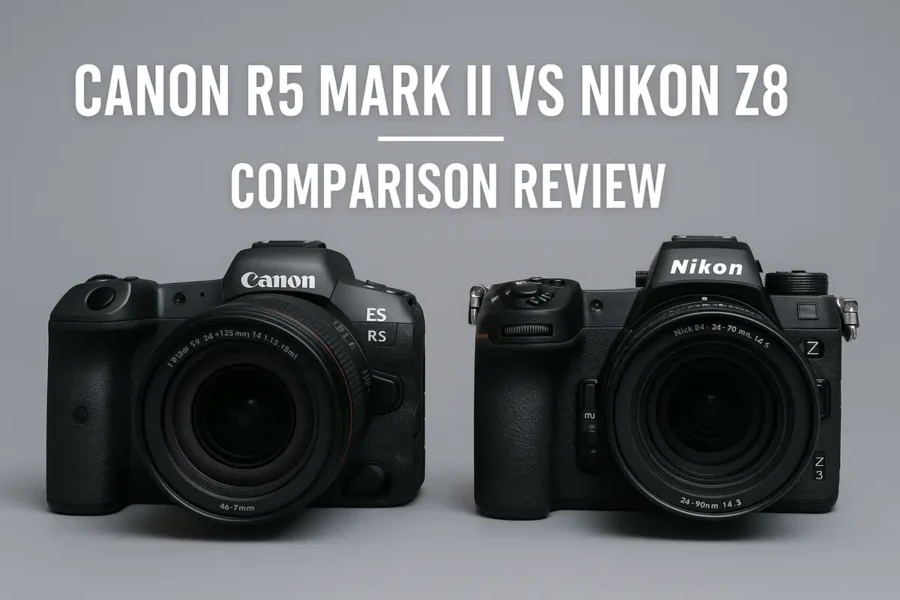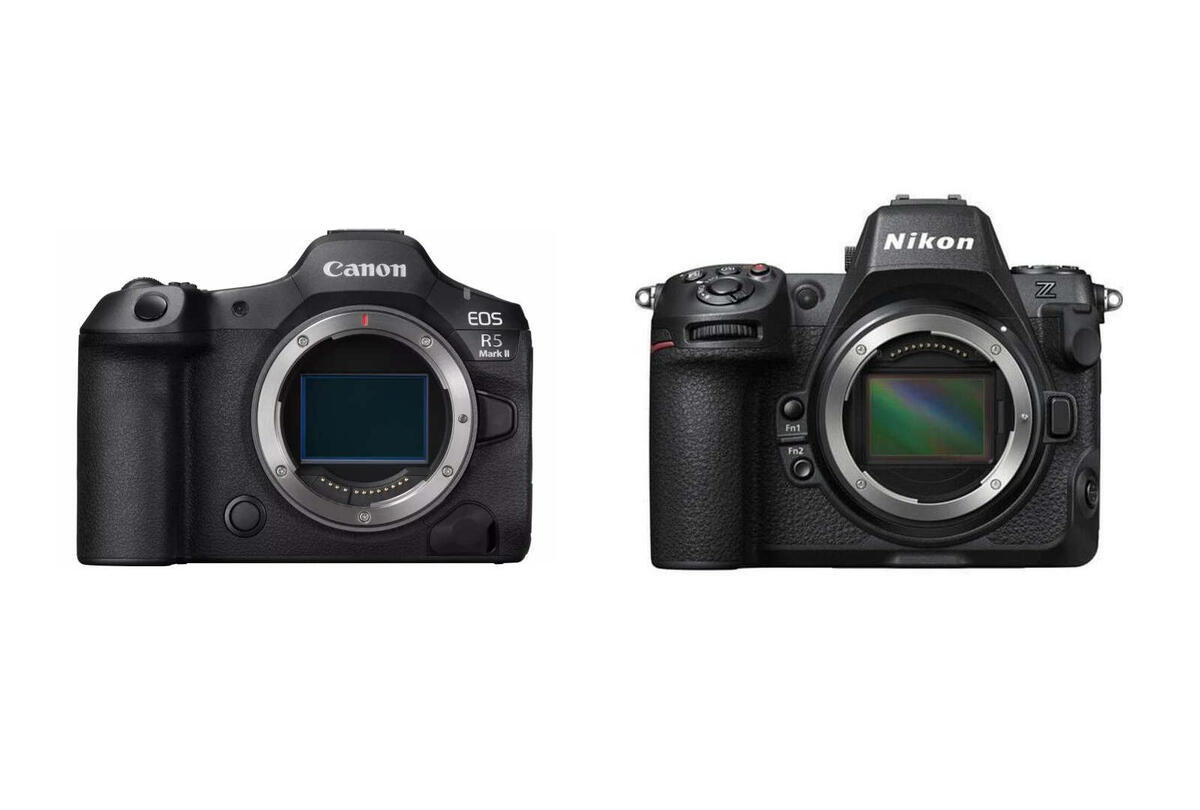The battle between Canon R5 Mark II vs Nikon Z8 is heating up in 2025, as both brands continue pushing the boundaries of mirrorless camera technology. Whether you’re a professional photographer or a serious enthusiast, choosing between these two powerhouses is no easy task. In this comparison review, we break down the specs, features, and performance of the Canon R5 Mark II and Nikon Z8 to help you decide which one fits your shooting style and creative needs.
Choosing between the Canon R5 Mark II vs Nikon Z8 can be a tough decision for photographers and videographers looking for a high-performance mirrorless camera in 2025. Both offer cutting-edge technology, superb image quality, and advanced video capabilities. In this comparison review, we’ll break down the key features, performance, and value of each model to help you decide which camera suits your creative needs best. Whether you’re upgrading from an older system or entering the pro mirrorless market, this Canon R5 Mark II vs Nikon Z8 review highlights what sets these two powerhouses apart. Let’s dive into the details.
Comparison Table
Here’s a quick side-by-side comparison table of the Canon R5 Mark II vs Nikon Z8 to help you quickly evaluate their features:
| Feature | Canon R5 Mark II | Nikon Z8 |
|---|---|---|
| Sensor | 45MP Full-Frame CMOS | 45.7MP Full-Frame Stacked CMOS |
| Image Processor | DIGIC X2 (Updated) | EXPEED 7 |
| Autofocus | Dual Pixel CMOS AF II with AI Tracking | Advanced AF with 3D Tracking & Subject Detection |
| Burst Shooting | 30fps (electronic), 12fps (mechanical) | 20fps RAW, 30fps JPEG |
| Video Resolution | 8K @ 60fps, 4K @ 120fps, 10-bit internal | 8K @ 60fps, 4K @ 120fps, ProRes RAW |
| Viewfinder | 5.76M-dot OLED EVF | 5.76M-dot OLED EVF |
| LCD Screen | 3.2” Fully Articulating Touchscreen | 3.2” Tilting Touchscreen |
| Image Stabilization | 8-stop In-Body IS | 6-stop In-Body IS |
| Storage | Dual slots (1x CFexpress, 1x SD UHS-II) | Dual slots (1x CFexpress, 1x SD UHS-II) |
| Connectivity | Wi-Fi, Bluetooth, USB-C, HDMI | Wi-Fi, Bluetooth, USB-C, HDMI |
| Battery Life | Approx. 480 shots (CIPA) | Approx. 700 shots (CIPA) |
| Build & Weather Sealing | Magnesium Alloy, Weather-Sealed | Magnesium Alloy, Weather-Sealed |
| Price (Body Only) | ~$3,999 USD at B&H, Adorama, Amazon | ~$3,999 USD B&H, Adorama, Amazon |
Design and Build Quality
When it comes to design, both cameras offer solid, weather-sealed builds ideal for demanding environments.
-
Canon R5 Mark II continues the ergonomic excellence of its predecessor, featuring a comfortable grip and intuitive control layout. The updated magnesium alloy body is lightweight but rugged.
-
Nikon Z8 draws design inspiration from the flagship Z9 but in a more compact body. It’s slightly larger than the R5 Mark II but offers exceptional build quality and pro-level durability.
In terms of usability, both cameras are well-balanced, but Canon may appeal more to those already in the EOS ecosystem, while Nikon Z users will appreciate the familiar interface of the Z8.
Sensor and Image Quality
At the heart of the Canon R5 Mark II lies a newly developed 45MP full-frame sensor with improved low-light performance and dynamic range. Paired with Canon’s latest DIGIC processor, it delivers sharp, vibrant images even in challenging lighting.
The Nikon Z8 also boasts a 45.7MP full-frame stacked CMOS sensor – the same sensor as in the flagship Nikon Z9. The Z8’s sensor delivers outstanding detail, color accuracy, and excellent noise control.
Verdict: Image quality is superb on both cameras. The Canon R5 Mark II edges ahead with slight improvements in dynamic range, but the Nikon Z8 matches it closely with its reliable and consistent output.
Autofocus Performance
Autofocus is one of the most important aspects for professionals, especially those in wildlife, sports, or action photography.
-
Canon R5 Mark II uses the upgraded Dual Pixel CMOS AF II system with deep learning AI subject tracking. It can track eyes, faces, animals, and vehicles with remarkable accuracy and speed.
-
Nikon Z8 features a fast and intelligent autofocus system based on the Z9, offering 3D tracking, subject recognition, and eye-detect AF that’s lightning-fast and highly dependable.
Verdict: It’s a close call, but the Canon R5 Mark II has a slight edge in AF versatility and subject detection.
Video Capabilities
For hybrid shooters, video is just as important as stills – and both cameras deliver.
-
Canon R5 Mark II supports 8K RAW internal recording at up to 60fps and 4K at 120fps. Overheating issues that plagued the original R5 have been addressed with better thermal management.
-
Nikon Z8 also shoots 8K video up to 60fps and 4K at 120fps. It offers internal 10-bit N-Log and Apple ProRes RAW for serious video production.
Both cameras offer excellent in-body image stabilization, high-resolution recording, and robust video features.
Verdict: A tie. Both cameras cater exceptionally well to videographers, with the Canon R5 Mark II pulling slightly ahead in heat management and color science.
Burst Shooting and Buffer
Speed is key for sports and wildlife photographers.
-
Canon R5 Mark II offers up to 30fps burst shooting with the electronic shutter and 12fps with the mechanical shutter. The improved buffer allows for longer continuous shooting.
-
Nikon Z8 also delivers 20fps RAW and 30fps JPEG shooting, with a deep buffer thanks to the EXPEED 7 processor.
Verdict: The Canon R5 Mark II wins by a hair with faster maximum burst speeds in certain modes.
Display and Viewfinder
Both cameras offer high-quality EVFs and LCDs.
-
Canon R5 Mark II features a 5.76M-dot EVF and a fully articulating 3.2-inch touchscreen LCD, perfect for vloggers and content creators.
-
Nikon Z8 sports the same EVF resolution with a tilt-only screen, which some may find limiting for video work or selfies.
Verdict: Canon R5 Mark II wins for flexibility thanks to the fully articulating screen.
Connectivity and Battery Life
Both models offer dual card slots (CFexpress + SD), USB-C, HDMI, mic and headphone jacks, Wi-Fi, and Bluetooth.
-
Canon R5 Mark II supports faster file transfer and remote control via Canon’s updated app.
-
Nikon Z8 offers similar wireless options, with high-speed tethering and FTP for professional workflows.
In terms of battery life, the Nikon Z8 has a slight edge due to its larger EN-EL15c battery and efficient power management.
Price and Value
Pricing may vary depending on the region and bundle, but here’s the approximate breakdown:
Both are premium-priced cameras aimed at professionals and serious enthusiasts. Value-wise, it comes down to brand preference and system investment.
Final Verdict
Canon R5 Mark II vs Nikon Z8 – which one should you choose?
-
Go with the Canon R5 Mark II if you value class-leading autofocus, a fully articulating screen, and Canon’s cinematic color science. It’s perfect for hybrid creators who shoot both high-end video and stills.
-
Choose the Nikon Z8 if you want the proven performance of the Z9 in a compact body, especially for fast-paced photography like sports or wildlife.
Both cameras are top-tier in their class and choosing one ultimately comes down to your personal workflow, lens ecosystem, and shooting preferences.
Whether you’re upgrading your gear or entering the pro mirrorless world, this comparison review shows that Canon R5 Mark II vs Nikon Z8 is one of the most exciting matchups of the year. No matter which you pick, you’re getting a powerhouse camera ready to handle anything you throw at it.
This Canon R5 Mark II vs Nikon Z8 comparison review aims to guide you in choosing the best tool for your creative journey. Whichever you choose, you’re getting top-tier performance and innovation.


